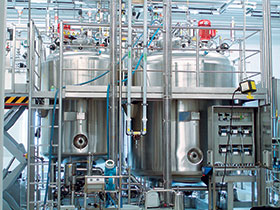

Many factory environments have applications involving the measurement, control and regulation of raw materials. These applications would fall under the realm of process automation (PA). Many other applications fall under the umbrella of factory automation (FA).
It is important to distinguish between the two, as each has its own unique requirements. While efficiency is key in both, there are enough differences to necessitate a different approach in automation.
PA systems must generally be robust and simple in order to handle corrosive liquids and hazardous materials. They are slow and continuous and therefore require less sophisticated equipment to control. FA, by contrast, calls for more complex and fast moving handling systems and control. Typical equipment would be actuated valves, tubing and pneumatic connections to solenoid valves.
It’s easy enough to get the distinction right when your plant works primarily with one type of automation. A process-focused plant, such as a water treatment facility, will have greater insight into the types of systems and components necessary to automate its processes. However, a factory with only select PA applications may lack the knowledge to optimise these particular systems.
Dangerous binds
There can be negative consequences associated with failure to automate processing applications. One such drawback is the increased exposure employees may have to hazardous material. A tyre factory that has its workers handle rubber manually is a good example.
Then there are the financial consequences. Inefficient dosing, which results in variations in the final product and wastage of raw material, is one such drawback. And with manual processing of material comes a higher chance of contamination.
Give me some sugar
Our observations have been that factory owners tend to invest heavily in automation technologies in the production environment, while continuing to process raw materials manually. Let’s take a real-life example within the food industry: a beer brewing company that has the latest technology dedicated to applications like packaging, labelling and inspecting, while relying on manual processing of sugar.
This was the case before a brewery recently chose to automate its sugar distribution system. Before, they would load sugar by hand. After installing a fully automated distribution system, the company experienced a quantum leap in efficiency. It is now able to automatically transport dry sugar from trucks to silos to the production environment, making distribution loss almost negligible. It has also reduced the chance of contamination in the final product due to cleaner raw materials.
The automation advantage
When choosing to automate processing applications within a factory environment, it is important to deal with a supplier specialising in PA. We recently dealt with a customer that had bought valve and actuator assemblies for a steam application. Because they had ordered it from a supplier that did not understand the PA environment, the components were not robust enough and started to leak.
By dealing with a company that specialises in PA, factories have access not only to the expertise required to build an optimised system, but also the availability of the specific products required. In the example above, we were able to identify and source the right components for a replacement assembly in a very short space of time.
Luckily, we are seeing more factories identify the weaknesses in their processing applications and addressing them accordingly. For those that haven’t yet made the leap, we recommend they take a close look at their processes and see which of those might be letting them down.
For more information contact Festo, 086 003 3786, [email protected], www.festo.co.za
| Email: | [email protected] |
| www: | www.festo.co.za |
| Articles: | More information and articles about Festo South Africa |

© Technews Publishing (Pty) Ltd | All Rights Reserved